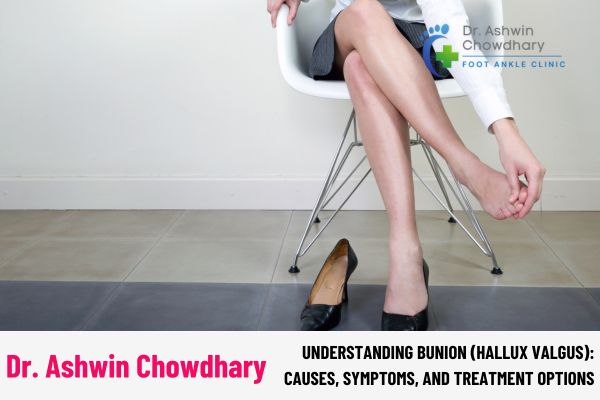Understanding Bunions (Hallux Valgus): Causes, Symptoms, and Treatment Options – With Dr. Ashwin Chowdhary
A bunion, medically known as Hallux Valgus, is a bony bump that forms at the base of the big toe. It develops when the big toe pushes against the next toe, causing the joint to enlarge and protrude. Over time, this can lead to pain, discomfort, and difficulty walking. Dr. Ashwin Chowdhary, an expert foot and ankle surgeon, discusses the causes, symptoms, and treatment options for bunions to help patients manage this condition effectively.
What Causes Bunions?
Bunions develop due to various factors, including:
- Genetics: A family history of bunions increases the likelihood of developing them.
- Footwear: Tight, narrow, or high-heeled shoes can contribute to bunion formation.
- Foot Structure: Flat feet, low arches, or abnormal foot mechanics can lead to bunions.
- Medical Conditions: Arthritis, particularly rheumatoid arthritis, can exacerbate bunions.
- Injury: Foot trauma or repetitive stress on the big toe joint can trigger bunion formation.
Common Symptoms of Bunions
Bunions typically develop gradually, with symptoms including:
- A visible bump on the side of the big toe joint
- Pain and tenderness around the joint
- Swelling, redness, or inflammation
- Restricted movement in the big toe
- Corns or calluses due to friction from shoes
- Difficulty wearing shoes due to discomfort
Treatment Options for Bunions
Bunion treatment depends on the severity of the condition and its impact on daily activities.
Non-Surgical Treatments
Mild to moderate bunions can often be managed with:
- Proper Footwear: Choosing wide-toe shoes with proper arch support.
- Orthotics: Custom shoe inserts to relieve pressure and improve foot alignment.
- Padding & Taping: Protects the bunion and helps align the foot properly.
- Medications: Over-the-counter pain relievers to reduce inflammation.
- Ice Therapy: Helps reduce swelling and pain after prolonged activity.
- Physical Therapy: Strengthening exercises to improve foot mechanics.
Surgical Treatments
If conservative measures fail to relieve symptoms, surgery may be necessary. Bunion surgery (bunionectomy) involves:
- Removing the bony bump
- Realigning the toe joint
- Correcting foot structure to prevent recurrence
Dr. Ashwin Chowdhary advises surgery only when bunions cause severe pain or interfere with daily activities.
Preventing Bunions
While not all bunions can be prevented, these steps can reduce the risk:
- Wear comfortable, well-fitted shoes with a wide toe box.
- Avoid prolonged use of high heels or narrow footwear.
- Use orthotic inserts if you have flat feet or abnormal foot structure.
- Perform foot-strengthening exercises to maintain mobility and flexibility.
When to See a Doctor
Consult an orthopedic specialist if you experience:
- Persistent pain that affects walking
- Swelling or redness that doesn’t improve
- Difficulty finding comfortable footwear
- Deformity or worsening misalignment of the toe
Conclusion
Bunions can be painful and limit mobility, but with the right treatment approach, relief is possible. Dr. Ashwin Chowdhary emphasizes early intervention with conservative treatments and, when necessary, surgical options for long-term relief. If you’re experiencing bunion discomfort, seeking expert care can help restore comfort and function to your feet.

